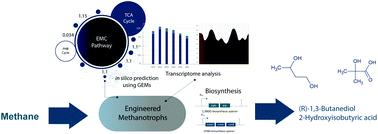当前位置:
X-MOL 学术
›
Green Chem.
›
论文详情
Our official English website, www.x-mol.net, welcomes your
feedback! (Note: you will need to create a separate account there.)
The ethylmalonyl-CoA pathway for methane-based biorefineries: a case study of using Methylosinus trichosporium OB3b, an alpha-proteobacterial methanotroph, for producing 2-hydroxyisobutyric acid and 1,3-butanediol from methane
Green Chemistry ( IF 9.3 ) Pub Date : 2021-09-02 , DOI: 10.1039/d1gc02866a Dung Hoang Anh Mai 1 , Thu Thi Nguyen 1 , Eun Yeol Lee 1
Green Chemistry ( IF 9.3 ) Pub Date : 2021-09-02 , DOI: 10.1039/d1gc02866a Dung Hoang Anh Mai 1 , Thu Thi Nguyen 1 , Eun Yeol Lee 1
Affiliation

|
The ethylmalonyl-CoA pathway is one of three known anaplerotic pathways that replenish tricarboxylic acid cycle intermediates and plays a major role in the carbon metabolism of many alpha-proteobacteria including Methylosinus trichosporium OB3b. Despite being less popular than the ribulose monophosphate pathway from gamma-proteobacterial methanotrophs, theoretically, a functional EMC pathway coupled with the serine cycle can achieve higher carbon usage efficiency, wherein one CO2 and one HCO3− are re-assimilated into biomass. Therefore, it is an attractive pathway for biomass-derived products such as biopolymers. However, efforts to harness the ethylmalonyl-CoA pathway in alpha-proteobacterial methanotrophs for biosynthesizing chemical compounds have been limited. As groundwork for future studies, in this study, various exploratory tools were employed to evaluate the regulatory nodes of this pathway and identify potential ethylmalonyl-CoA pathway-derived products in Methylosinus trichosporium OB3b. Based on transcriptomic analysis coupled with genome-scale metabolic model prediction, the production of 2-hydroxyisobutyric acid and 1,3-butanediol from methane was chosen and demonstrated. These two compounds are derived from the dynamic flux branching node of the ethylmalonyl-CoA pathway and poly(3-hydroxybutyrate) pathways. Furthermore, starting from acetyl-CoA there is no carbon loss. By knocking out phaC that encodes polyhydroxybutyrate synthase, and inducing the PHB overflow mechanism, 2HIBA and 1,3-BDO titers were improved to 29.99 ± 1.827 mg L−1 and 60.51 ± 3.805 mg L−1, respectively. The current work demonstrated the first proof of concept for the production of EMC-derived products from methane.
中文翻译:

基于甲烷的生物精炼厂的乙基丙二酰辅酶 A 途径:使用 Methylosinus trichosporium OB3b(一种 α-变形菌甲烷氧化菌)从甲烷中生产 2-羟基异丁酸和 1,3-丁二醇的案例研究
乙基丙二酰辅酶 A 途径是三种已知的补补途径之一,可补充三羧酸循环中间体,并在包括Methylosinus trichosporium OB3b在内的许多 α-变形菌的碳代谢中起主要作用。尽管不如来自 γ-变形菌甲烷氧化菌的单磷酸核酮糖途径受欢迎,但理论上,与丝氨酸循环结合的功能性 EMC 途径可以实现更高的碳利用效率,其中一个 CO 2和一个 HCO 3 -被重新同化为生物质。因此,它是生物质衍生产品(如生物聚合物)的一个有吸引力的途径。然而,利用 alpha-proteobacterial methanotrophs 中的乙基丙二酰辅酶 A 途径来生物合成化合物的努力受到限制。作为未来研究的基础,在本研究中,采用了各种探索性工具来评估该途径的调控节点,并在Methylosinus trichosporium 中鉴定潜在的乙基丙二酰辅酶 A 途径衍生产品OB3b。基于转录组学分析和基因组规模的代谢模型预测,选择并证明了从甲烷中生产 2-羟基异丁酸和 1,3-丁二醇。这两种化合物源自乙基丙二酰辅酶A途径和聚(3-羟基丁酸)途径的动态通量分支节点。此外,从乙酰辅酶A开始没有碳损失。通过敲除编码多羟基丁酸合酶的phaC,并诱导 PHB 溢出机制,2HIBA 和 1,3-BDO 滴度分别提高到 29.99 ± 1.827 mg L -1和 60.51 ± 3.805 mg L -1。目前的工作展示了从甲烷生产 EMC 衍生产品的第一个概念证明。
更新日期:2021-09-13
中文翻译:

基于甲烷的生物精炼厂的乙基丙二酰辅酶 A 途径:使用 Methylosinus trichosporium OB3b(一种 α-变形菌甲烷氧化菌)从甲烷中生产 2-羟基异丁酸和 1,3-丁二醇的案例研究
乙基丙二酰辅酶 A 途径是三种已知的补补途径之一,可补充三羧酸循环中间体,并在包括Methylosinus trichosporium OB3b在内的许多 α-变形菌的碳代谢中起主要作用。尽管不如来自 γ-变形菌甲烷氧化菌的单磷酸核酮糖途径受欢迎,但理论上,与丝氨酸循环结合的功能性 EMC 途径可以实现更高的碳利用效率,其中一个 CO 2和一个 HCO 3 -被重新同化为生物质。因此,它是生物质衍生产品(如生物聚合物)的一个有吸引力的途径。然而,利用 alpha-proteobacterial methanotrophs 中的乙基丙二酰辅酶 A 途径来生物合成化合物的努力受到限制。作为未来研究的基础,在本研究中,采用了各种探索性工具来评估该途径的调控节点,并在Methylosinus trichosporium 中鉴定潜在的乙基丙二酰辅酶 A 途径衍生产品OB3b。基于转录组学分析和基因组规模的代谢模型预测,选择并证明了从甲烷中生产 2-羟基异丁酸和 1,3-丁二醇。这两种化合物源自乙基丙二酰辅酶A途径和聚(3-羟基丁酸)途径的动态通量分支节点。此外,从乙酰辅酶A开始没有碳损失。通过敲除编码多羟基丁酸合酶的phaC,并诱导 PHB 溢出机制,2HIBA 和 1,3-BDO 滴度分别提高到 29.99 ± 1.827 mg L -1和 60.51 ± 3.805 mg L -1。目前的工作展示了从甲烷生产 EMC 衍生产品的第一个概念证明。











































 京公网安备 11010802027423号
京公网安备 11010802027423号